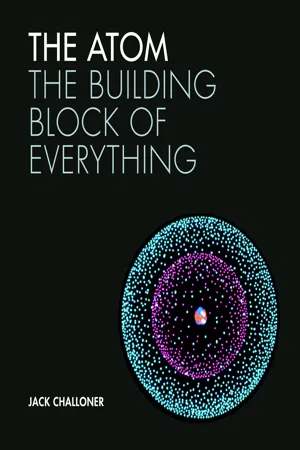CHAPTER 1
A BRIEF HISTORY OF THE CONCEPT “ATOM”
The idea that matter is made of tiny particles is at least 2,500 years old. Through much of history, it was relegated to the fringes of scientific thought for philosophical and religious reasons. But it regained popularity with the rise of science in Europe in the seventeenth and eighteenth centuries. The notion that atoms really do exist only became widely accepted with the rapid rise of atomic physics in the early twentieth century.
Molecular models presented to the Royal Institution, London, UK, by German chemist August Wilhelm von Hofmann, in 1865. Hoffman used the models in a lecture entitled “The Combining Power of Atoms,” at a time when the existence of atoms was still in doubt.
EVERYTHING AND NOTHING
The roots of modern atomic theory lie in ancient Greece. Oddly, perhaps, the story begins with philosophical wrangling about whether change is real or an illusion—and whether empty space can exist. Despite the development of well-thought-out and convincing atomic theories in both Greece and India, other ideas would come to dominate.
EVERYTHING CHANGES—OR DOES IT?
It was common for ancient Greek philosophers—as it is for scientists these days—to seek order in the world, and in particular to find a unified cause for the huge variety of phenomena we observe. When it comes to the physical world, or matter, the earliest Greek philosophers were “monists.” They proposed that either all matter begins as one kind of substance and then differentiates, or that there actually is only one kind of matter, which manifests in various forms.
One of the earliest Greek philosophers, Thales of Miletus (ca. 625–ca. 545 BCE), suggested that water might be the primary substance from which all other substances derive. Anaximenes, also of Miletus, thought that the primary substance might be air.
Several decades later, another Greek philosopher, Heraclitus of Ephesus (ca. 535–ca. 475 BCE), suggested that the primary material might be fire. His reasoning was that fire is an agent of change—and, our senses report, change is a vital and constant feature of the world. A contemporary of Heraclitus, Parmenides of Elea (born ca. 515 BCE), believed quite the opposite. Parmenides and his followers rejected the empirical experiences of the senses, relying instead on pure reason. They believed that all change is an illusion, that it simply does not exist.
Parmenides’s notion that change is an illusion followed from his belief that “nothingness” could not exist. He argued that the supposedly “changed” state of a thing is different from the original thing and so did not previously exist; it would therefore have to have come from nothing. Parmenides even rejected the idea that things could move. Motion was impossible, he said, because it would require the existence of “void,” or empty space, into which an object could move—and void was the same as “nothingness.” For Parmenides, reality was one perfect, full, unchanging sphere that had always existed and in which nothing ever changed. He called it the plenum. We will return to this notion in the context of modern theoretical physics in chapter seven.
ATOMS—MAKING SENSE OF CHANGE
The views of Parmenides were influential in ancient Greece, and the philosophers who succeeded him felt compelled to take his views into account. One of them was Democritus (ca. 460–370 BCE), widely credited with the first comprehensive atomic theory (although there were similar ideas in India at about the same time, see the box shown here). Democritus attempted to reconcile Parmenides’s notion of reality as an unchanging whole with the fact that change does seem to happen. He did so by making two adjustments to Parmenides’s ideas. First, he suggested that “void,” or empty space, can exist. Second, he proposed that all matter is made of tiny, indivisible particles. The individual particles retain their identity and their total number remain the same, so overall there is no change. But change can occur locally, because particles can move around, collide with one another, join and break apart, and rearrange themselves.
Democritus described his particles as ἄτομος (atomos, meaning “indivisible”). The word comes from ἀ- (a-, “not”) and τέμνω (témnō, “I cut”). He also supposed that the particles are always in motion and that they are identical apart from their size and shape.
The doctrine of monism proposes that everything is made of, or arises from, just one kind of matter—but how can an ocean, rocks, soaring birds, and clouds be made of the same thing?



